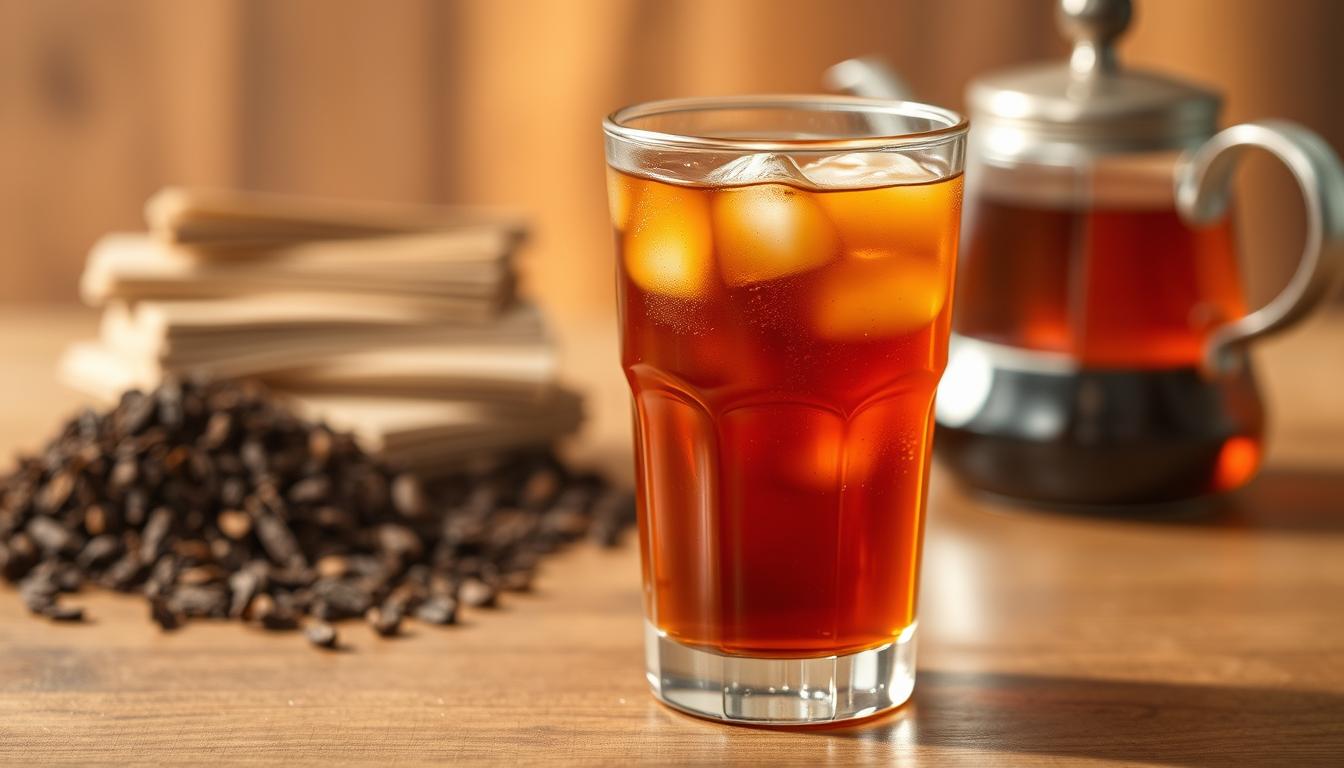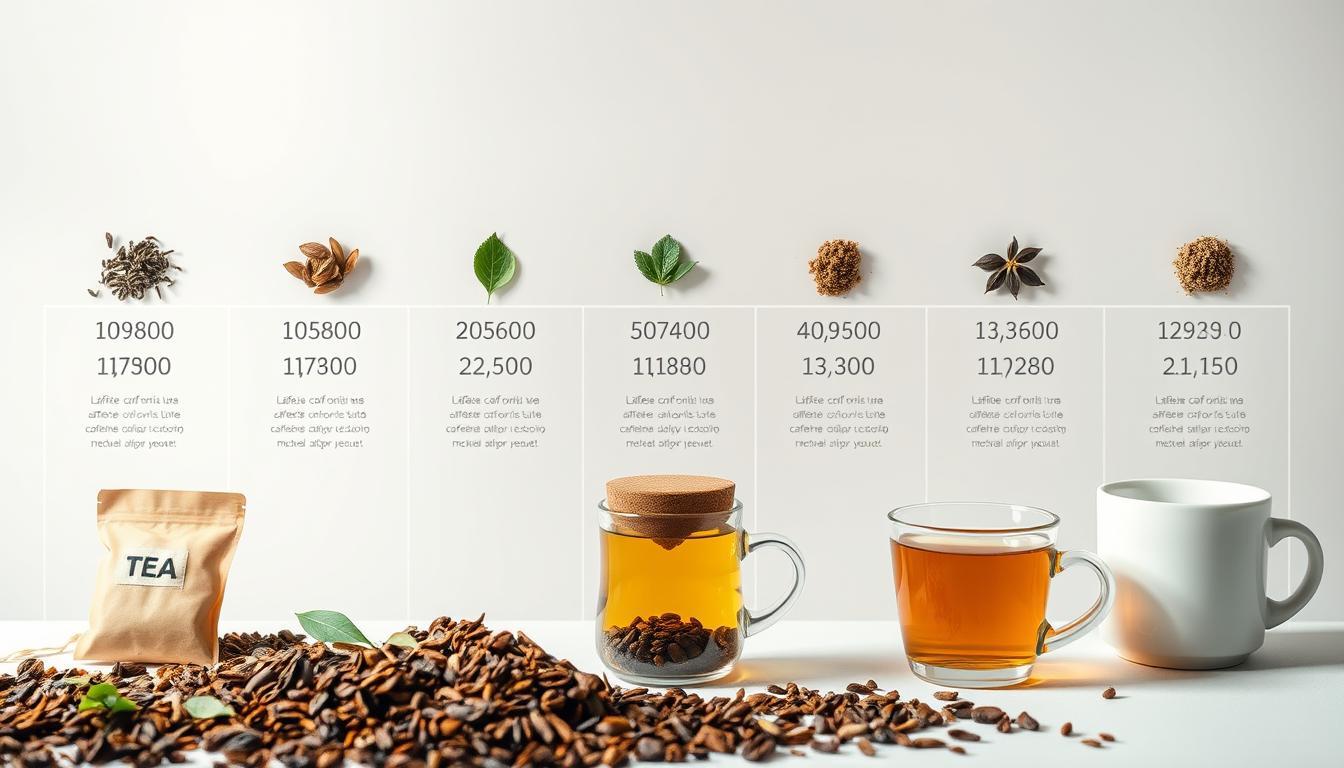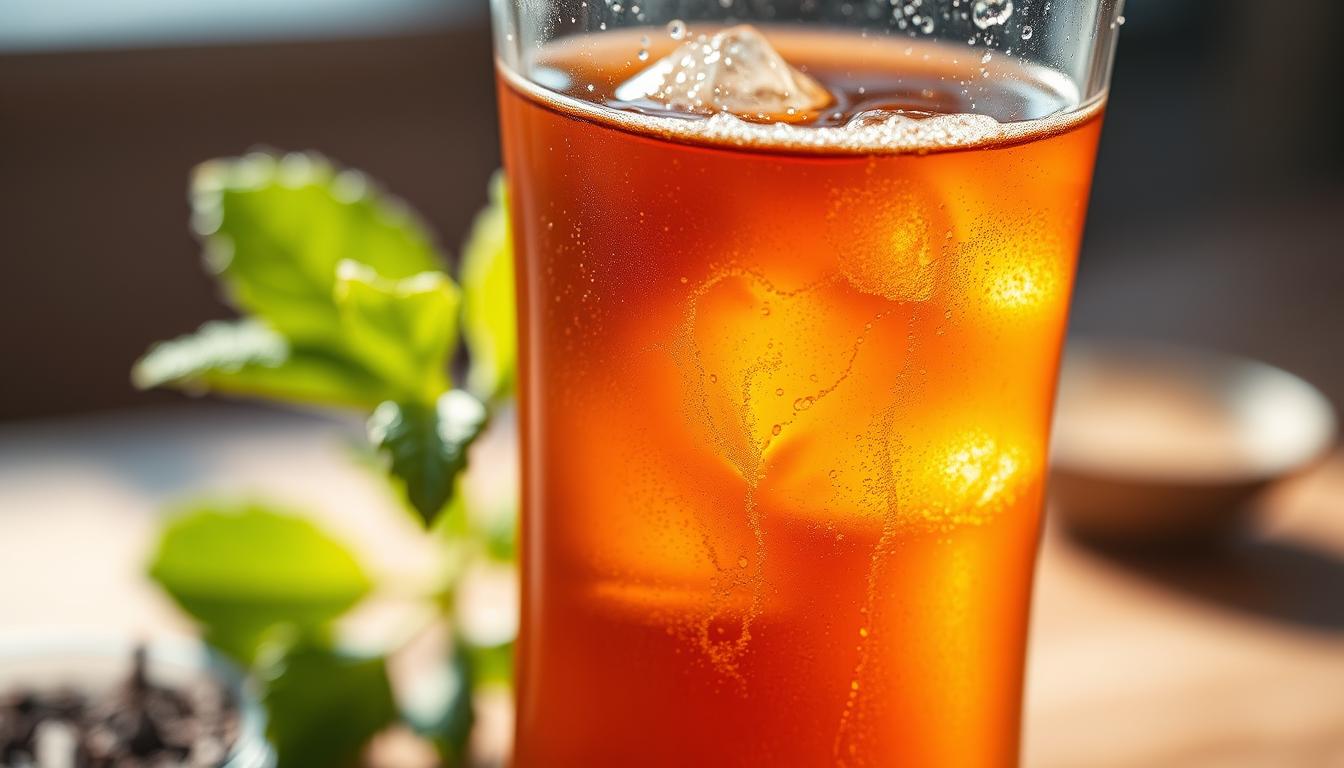Did you know that over 80% of Americans consume caffeinated beverages daily? Among these, iced tea stands out as a refreshing favorite, especially during the summer months. But how much caffeine does it actually contain?
Iced tea is typically made from black tea, which naturally contains caffeine. However, the amount can vary widely depending on the type of tea, how it’s brewed, and whether it’s homemade or store-bought. This makes it a versatile drink for both caffeine lovers and those who prefer a milder option.
Understanding the caffeine content in your iced tea can help you make better choices for your lifestyle. Whether you’re looking for a quick energy boost or a relaxing drink, knowing the basics can guide your decision.
Key Takeaways
- Iced tea is a popular beverage, especially in the summer.
- Most iced tea is made from black tea, which contains caffeine.
- Caffeine levels vary based on the type of tea and preparation method.
- Both homemade and store-bought versions are discussed in later sections.
- Understanding caffeine content helps you make informed choices.
Overview of Iced Tea and Caffeine
When the sun is high, nothing beats a glass of iced tea. This beverage has earned its place as a summer staple, offering a cool escape from the heat. Its versatility allows it to be enjoyed plain, sweetened, or infused with fruits and herbs, making it a favorite for many.

Caffeine plays a significant role in why people choose iced tea. For some, it provides a gentle energy boost without the intensity of coffee. Others appreciate the balance it brings to their day. The amount of caffeine can vary, depending on the type of tea and how it’s prepared.
What Makes Iced Tea a Summer Staple?
Iced tea’s refreshing nature makes it a go-to drink during warm weather. Its light and crisp flavor quenches thirst while offering a pleasant taste. Whether you prefer it sweetened or unsweetened, it’s a drink that can be customized to suit any palate.
Brewing methods also influence its appeal. Cold brew techniques, for example, result in a smoother taste, while hot brewing extracts more flavor and caffeine. Steeping time further affects the strength, allowing you to tailor the drink to your liking.
The Role of Caffeine in Your Beverage Choice
Caffeine content is a key factor for many when selecting a beverage. Iced tea offers a middle ground between coffee and decaf options. Black tea, commonly used in iced tea, contains moderate caffeine levels, making it a great choice for those seeking a mild pick-me-up.
For those sensitive to caffeine, green tea or herbal infusions can be excellent alternatives. These options provide unique flavors and lower caffeine levels, ensuring there’s something for everyone. Understanding these differences helps you make informed choices that align with your preferences.
When crafting your own iced tea, adjusting the recipe can enhance both flavor and caffeine content. Experimenting with brewing time and tea types allows you to create a drink that’s perfectly suited to your taste and energy needs.
Caffeine Content in Different Types of Tea
Not all teas are created equal when it comes to caffeine content. The type of leaves used, the blend, and even the quality of the tea can influence how much caffeine ends up in your cup. Whether you’re sipping on a classic black tea or enjoying a soothing herbal infusion, understanding these differences can help you make the right choice for your needs.

Comparing Black, Green, and White Teas
Black tea is known for its robust flavor and higher caffeine levels. On average, an 8-ounce cup contains between 40-70 milligrams of caffeine. Brands like Lipton and Snapple often use black tea as their base, making it a popular choice for iced tea lovers.
Green tea, on the other hand, offers a milder option with caffeine levels ranging from 20-45 milligrams per cup. Its lighter taste and lower caffeine content make it a favorite for those seeking a gentle energy boost.
White tea is the least processed of the three, with caffeine levels typically between 15-30 milligrams. Its delicate flavor and minimal caffeine make it an excellent choice for those who prefer a subtler experience.
Herbal Infusions vs. Traditional Teas
Unlike traditional teas, herbal infusions are naturally caffeine-free. Made from herbs, flowers, and spices, they offer a wide range of flavors without the stimulating effects of caffeine. Popular options include chamomile, peppermint, and rooibos, which are perfect for relaxing moments.
When comparing herbal blends to traditional teas, the key difference lies in their caffeine content. While black, green, and white teas derive their caffeine from the Camellia sinensis plant, herbal infusions rely on other ingredients for their unique tastes.
Whether you’re brewing at home or grabbing a bottle from the store, the type of tea you choose will determine its caffeine levels. From bold black tea to calming herbal blends, there’s a perfect option for every preference.
The Impact of Brewing Methods on Caffeine Levels
The way you brew your drink can significantly change its caffeine levels. Whether you prefer a hot or cold method, the brewing process plays a key role in determining the final result. Understanding these differences can help you tailor your drink to your preferences.
Hot Brew Versus Cold Brew Techniques
Hot brewing is a traditional method that extracts more caffeine from the leaves. The higher temperature helps release compounds quickly, resulting in a stronger flavor and higher caffeine content. This method is ideal for those who enjoy a bold and energizing drink.
Cold brewing, on the other hand, is a slower process. It involves steeping leaves in cold water for several hours. This technique produces a smoother, milder flavor with less caffeine. It’s perfect for those who want a refreshing drink without the intense kick.
Steeping Time and Its Effects
The length of time you steep your leaves also impacts caffeine levels. A longer steeping time allows more caffeine to be extracted, making the drink stronger. Shorter steeping times result in a lighter flavor and lower caffeine content.
For hot brewing, steeping for 3-5 minutes is common. Cold brewing typically requires 8-12 hours. Adjusting the steeping time gives you control over the strength and flavor of your drink.
Here are some practical tips for home brewers:
- Use hot water for a quicker, stronger brew.
- Opt for cold water if you prefer a milder taste.
- Experiment with steeping times to find your perfect balance.
By understanding the brewing process and the role of steeping time, you can create a drink that suits your taste and energy needs. Whether you’re a fan of bold flavors or prefer something lighter, the choice is yours.
Iced Tea versus Hot Tea: A Caffeine Comparison
Ever wondered how temperature affects your favorite drink? Whether you prefer it hot or cold, the way you brew your tea can influence its caffeine content. While both versions use the same leaves, the extraction process differs slightly based on temperature.
Hot tea is brewed using boiling water, which quickly extracts caffeine and flavor compounds. This method results in a robust and energizing drink. On the other hand, iced tea is often brewed cold or cooled after hot brewing, which can slow down caffeine extraction. Despite these differences, the overall caffeine content remains similar.
How Temperature Influences Caffeine Extraction
Temperature plays a significant role in how caffeine dissolves in water. Hot water accelerates the process, allowing more caffeine to be extracted in a shorter time. Cold water, however, takes longer to dissolve caffeine, resulting in a milder drink. This is why cold brew methods often require extended steeping times.
Interestingly, the type of tea leaves used also matters. Black tea, commonly used for iced tea, contains a moderate amount of caffeine. Green and white teas, which are often enjoyed hot, have slightly lower levels. Regardless of the brewing method, the caffeine content in your drink depends on the leaves and steeping time.
Here’s a quick comparison of caffeine levels in popular beverages:
| Beverage | Caffeine Content (per 8 oz) |
|---|---|
| Hot Black Tea | 40-70 mg |
| Iced Black Tea | 30-60 mg |
| Brewed Coffee | 95 mg |
When choosing between iced tea and coffee, consider the amount of caffeine you need. Coffee provides a stronger kick, while tea offers a gentler boost. Many people enjoy iced tea for its refreshing taste and moderate caffeine levels, making it a popular choice for any time of day.
Ultimately, the temperature of your brew doesn’t drastically change the caffeine content. Similar tea leaves will yield comparable results, whether served hot or cold. The choice comes down to personal preference and the experience you’re looking for.
Exploring Store-Bought Versus Homemade Iced Tea
Choosing between homemade and store-bought options can shape your iced tea experience. Both approaches offer unique benefits, whether you prioritize customization or convenience. Understanding the differences can help you decide which method suits your lifestyle best.
Customization and Ingredients in Home-Brewed Tea
Making iced tea at home allows you to control every ingredient and tailor the flavor to your liking. You can experiment with different tea leaves, sweeteners, and infusions to create a recipe that’s uniquely yours. This level of customization ensures your drink aligns perfectly with your taste preferences.
Additionally, home brewing lets you adjust the steeping time and tea-to-water ratio. This flexibility helps you manage the caffeine content and intensity of your beverage. Whether you prefer a bold black tea or a light herbal blend, the possibilities are endless.
Convenience and Consistency in Commercial Products
Store-bought iced tea offers unmatched convenience. Brands like Arizona and Snapple provide ready-to-drink options that save time and effort. These products are perfect for busy individuals who want a quick and refreshing drink.
Commercial products also ensure consistency in flavor and caffeine levels. Each bottle or can delivers the same taste and amount of caffeine, making it a reliable choice. This consistency is ideal for those who prefer a standardized experience.
Whether you choose homemade or store-bought, both options offer a variety of flavors and caffeine levels to suit your needs. The decision ultimately depends on your priorities—customization or convenience.
Specialty Iced Tea Blends and Their Caffeine Variations
Specialty iced tea blends bring a burst of creativity to your glass. These unique combinations often feature real fruit extracts and fresh herbs, offering a distinct flavor profile compared to traditional options. Whether you’re sipping on a lemon-infused blend or enjoying a soothing herb-based creation, these drinks cater to a wide range of tastes.
Fruit-Infused and Herbal-Infused Iced Teas
Fruit-infused iced teas are a popular choice for those seeking a refreshing and tangy experience. Ingredients like lemon, berries, and citrus add a natural sweetness, enhancing the drink’s appeal. These blends often have a lower caffeine content, making them ideal for those who prefer a milder option.
Herbal-infused varieties, on the other hand, rely on ingredients like mint, chamomile, or rooibos. These blends are naturally caffeine-free, offering a calming and aromatic experience. They’re perfect for relaxing moments or as a caffeine-free alternative to traditional tea.
Here’s what makes these blends stand out:
- Unique flavor combinations that cater to diverse preferences.
- Lower caffeine levels compared to standard black or green tea.
- A creative mix of taste and health benefits.
Specialty iced teas are not just about taste—they’re about innovation. By blending fruits, herbs, and tea leaves, these drinks offer a refreshing twist on a classic favorite. Whether you’re looking for a bold new flavor or a calming herbal infusion, there’s a specialty blend for everyone.
Decaffeinated Iced Tea: Removing Caffeine while Keeping Flavor
For those who love tea but want to avoid caffeine, decaffeinated options are a game-changer. These versions provide the same refreshing experience with less caffeine, making them ideal for evening enjoyment or for those sensitive to stimulants. The key lies in the process of removing caffeine while preserving the drink’s signature flavor.
Decaffeination involves specialized techniques to extract caffeine from tea leaves. The most common methods include chemical solvents and water-based processes. While chemical methods are efficient, they can slightly alter the flavor profile. Water-based methods, on the other hand, are gentler and often retain more of the tea’s natural taste.
Decaffeination Processes and Their Effects on Taste
The goal of decaffeination is to reduce caffeine content without compromising the tea’s essence. Chemical methods use solvents like ethyl acetate to dissolve caffeine, while water-based techniques rely on osmosis. Both approaches aim to minimize caffeine levels while maintaining the tea’s complexity.
Here’s how these methods compare:
- Chemical Decaffeination: Efficient but may leave a faint aftertaste.
- Water-Based Decaffeination: Preserves more of the tea’s natural flavor.
Decaffeinated teas are a great alternative to herbal blends, which are naturally caffeine-free. While herbal options like chamomile or peppermint offer unique flavors, decaffeinated teas provide the familiar taste of traditional varieties like green tea or black tea without the stimulating effects.
Ultimately, decaffeinated tea strikes a balance between less caffeine and rich flavor. Whether you’re winding down for the day or simply prefer a milder option, these blends ensure you don’t have to compromise on taste.
Comparing Iced Tea with Other Caffeinated Beverages
When it comes to caffeinated drinks, iced tea often stands in the shadow of coffee and energy drinks. Each beverage offers a unique experience, catering to different tastes and caffeine needs. Understanding their differences can help you make the best choice for your lifestyle.
Coffee is known for its bold flavor and high caffeine content, making it a go-to for a quick energy boost. Energy drinks, on the other hand, are packed with stimulants and often contain added sugars. Iced tea provides a refreshing middle ground, offering a smoother and more balanced alternative.
Coffee, Energy Drinks, and Bottled Options
Coffee typically contains 95 milligrams of caffeine per 8-ounce cup, while energy drinks can range from 70-200 milligrams. Iced tea, especially when made from black tea, usually has 30-60 milligrams. This makes it a gentler option for those who want a pick-me-up without the jitters.
Bottled iced tea options, like Arizona and Snapple, are convenient and consistent in flavor. These brands offer a variety of blends, from classic black tea to fruity infusions. While they may have slightly lower caffeine levels than homemade versions, they’re perfect for on-the-go enjoyment.
Here’s a quick comparison of caffeine levels in popular beverages:
| Beverage | Caffeine Content (per 8 oz) |
|---|---|
| Coffee | 95 mg |
| Energy Drink | 70-200 mg |
| Iced Tea | 30-60 mg |
The source of caffeine also varies. Coffee beans naturally contain caffeine, while energy drinks often add synthetic caffeine. Iced tea derives its caffeine from tea leaves, providing a more natural and milder option.
Flavor plays a significant role in choosing a drink. Coffee’s robust taste appeals to those who enjoy bold flavors, while energy drinks often have a sweet, tangy profile. Iced tea offers a crisp and refreshing taste, making it a versatile choice for any occasion.
Whether you prefer the intensity of coffee, the convenience of energy drinks, or the refreshing balance of iced tea, each drink has its place. Understanding their differences ensures you can enjoy your favorite beverage while meeting your caffeine needs.
Health Benefits and Considerations of Iced Tea Consumption
Looking for a refreshing drink that also offers health benefits? Iced tea might be your answer. This popular beverage is not only a thirst-quencher but also a source of antioxidants and hydration. Whether you enjoy it sweetened or unsweetened, it’s a versatile option for any time of day.
Antioxidants and Hydration Benefits
Iced tea is rich in antioxidants, particularly when made from green tea or black tea. These compounds help combat free radicals, supporting overall health. Regular consumption can contribute to a stronger immune system and improved skin health.
Unsweetened iced tea is also an excellent hydrating drink. It’s low in calories and provides a refreshing alternative to sugary beverages. Adding ingredients like lemon or peppermint can enhance its flavor while offering additional health perks.
Managing Caffeine Sensitivity
For those sensitive to caffeine, iced tea can still be enjoyed with a few adjustments. Opt for decaffeinated versions or naturally caffeine-free herbal blends. Ingredients like chamomile or rooibos provide a calming experience without the stimulating effects.
Here’s a quick comparison of caffeine levels in popular beverages:
| Beverage | Caffeine Content (per 8 oz) |
|---|---|
| Iced Tea | 30-60 mg |
| Coffee | 95 mg |
| Green Tea | 20-45 mg |
By choosing the right ingredient and preparation method, you can tailor your iced tea to meet your needs. Whether you’re looking for a hydrating drink or a caffeine-free option, there’s a blend for everyone.
Conclusion
Finding the perfect balance between flavor and energy can be a delightful journey. The content of caffeine in your drink varies based on the type of leaves and brewing methods. Whether you prefer hot or cold preparation, the steeping time plays a key role in shaping the taste and strength.
Both homemade and store-bought options offer unique benefits. Crafting your own recipe allows for customization, while commercial products provide convenience and consistency. The variety of blends ensures there’s something for everyone, from bold black to calming herbal infusions.
When choosing your drink, consider your personal preferences and health goals. Always review the source and labels to ensure the desired balance of flavor and energy. Enjoy the process of discovering your perfect match!

